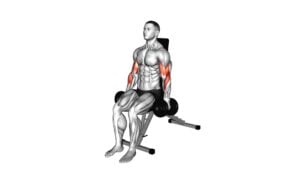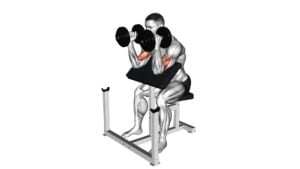Dumbbell Hammer Curl – Video Exercise Guide & Tips

Are you looking to tone your arms and build strength?
Watch This Exercise Video
The dumbbell hammer curl is a fantastic exercise that targets your biceps and forearms.
In this video exercise guide, we'll show you the proper form and technique to ensure you get the most out of this exercise.
We'll also provide tips for choosing the right dumbbells and avoiding common mistakes.
Get ready to increase the intensity of your workouts and challenge yourself with variations.
Let's get started!
Key Takeaways
- Stand with feet shoulder-width apart
- Hold dumbbells with a neutral grip
- Choose the right dumbbells based on fitness level and desired resistance
- Avoid common mistakes like using momentum, maintaining a neutral wrist position, and listening to your body
Proper Form and Technique
To perform the dumbbell hammer curl exercise correctly, start by standing with your feet shoulder-width apart and hold the dumbbells in each hand with a neutral grip.
The dumbbell hammer curl is a highly effective exercise that targets the biceps, forearms, and brachialis muscles. One of the main benefits of this exercise is that it helps to add size and strength to the biceps, creating a more defined and sculpted appearance.
Additionally, the neutral grip used in this exercise places less stress on the wrists and elbows compared to other curl variations, reducing the risk of strain or injury.
However, it's important to maintain proper form and technique to maximize the benefits and prevent wrist strain. To do so, keep your elbows close to your sides and avoid swinging or using momentum to lift the weights.
Focus on slowly curling the dumbbells up towards your shoulders while keeping your wrists straight.
Choosing the Right Dumbbells
When choosing the right dumbbells for the dumbbell hammer curl exercise, you should consider your current fitness level and the desired level of resistance. Dumbbell weight selection plays a crucial role in determining the effectiveness of your workout and avoiding injury.
To find the right size dumbbells, start by assessing your current strength and endurance. If you're a beginner or have limited upper body strength, it's recommended to start with lighter dumbbells, typically between 5 to 10 pounds. As you progress and build strength, you can gradually increase the weight.
On the other hand, if you're more experienced and looking to challenge yourself, opt for heavier dumbbells between 15 to 30 pounds. It's important to note that the weight should be challenging but not excessively heavy, as this can compromise your form and increase the risk of injury.
Remember to always listen to your body and make adjustments accordingly. By finding the right size dumbbells, you can maximize the benefits of the dumbbell hammer curl exercise and achieve your fitness goals safely and effectively.
Common Mistakes to Avoid
Avoid using too much momentum while performing the dumbbell hammer curl exercise. This is a common mistake that many people make, as they often swing their arms and use their body to help lift the dumbbells. However, using momentum takes away from the effectiveness of the exercise and can increase the risk of injury.
To ensure proper technique and get the most out of your dumbbell hammer curls, keep the following points in mind:
- Control the movement: Focus on controlling the weight throughout the entire range of motion. Avoid any sudden jerking or swinging motions.
- Maintain a neutral wrist position: Keep your wrists straight and avoid excessive wrist flexion or extension. This will help target the muscles in your forearms and biceps more effectively.
- Use a weight that challenges you: Select a weight that allows you to perform the exercise with proper form and technique. If you find yourself struggling to complete the repetitions or sacrificing form, it's a sign that the weight is too heavy.
Tips for Increasing Intensity
To ramp up the effectiveness of your dumbbell hammer curls, try incorporating these tips to increase the intensity of your workout.
First, consider increasing the weight of the dumbbells you're using. By gradually increasing the weight, you challenge your muscles and promote strength gains over time. Start with a weight that allows you to perform 10-12 reps with proper form, and then gradually increase the weight as you get stronger.
Another way to increase the intensity of your dumbbell hammer curls is through tempo control. Instead of rushing through the exercise, focus on controlling the movement and slowing down the tempo. This can be achieved by performing both the concentric and eccentric phases of the exercise at a slower pace. By doing so, you engage your muscles for a longer duration, leading to increased muscle activation and growth.
In addition to increasing weight and using tempo control, it's important to maintain proper form throughout the exercise. Keep your core engaged, shoulders back, and wrists straight. Avoid using momentum or swinging the weights to lift them. Instead, focus on using your biceps to curl the dumbbells up and down.
Incorporating Variations for Added Challenge
To add more challenge to your dumbbell hammer curl routine, try incorporating different variations of the exercise. Advanced modifications can help you break through plateaus and continue to see progress in your strength and muscle development.
Here are some benefits of incorporating variations:
- Increased muscle activation: By changing the grip or angle of the exercise, you can target different muscle fibers and stimulate growth in areas that may not be fully engaged during traditional hammer curls.
- Improved stability and balance: Trying variations that challenge your balance and stability, such as standing on one leg or using an unstable surface, can enhance your overall strength and coordination.
- Enhanced grip strength: Utilizing thicker handles or grip attachments can increase the demand on your forearms and grip, helping you develop stronger hands and wrists.
Remember to start with lighter weights when trying advanced modifications and focus on proper form to reduce the risk of injury. Experiment with different variations to keep your workouts interesting and continue challenging your muscles for optimal results.
Frequently Asked Questions
How Many Sets and Reps Should I Do for the Dumbbell Hammer Curl Exercise?
To determine the recommended weight, sets, and reps for the dumbbell hammer curl exercise, it's important to consider your fitness level and goals.
Start with a weight that challenges you but allows for proper form.
Aim for 2-3 sets of 8-12 reps per arm.
This will help build strength and muscle endurance.
Remember to always prioritize maintaining proper form throughout the exercise to maximize results and prevent injury.
Can I Do the Dumbbell Hammer Curl Exercise With a Barbell Instead of Dumbbells?
Yes, you can do the dumbbell hammer curl exercise with a barbell instead of dumbbells.
Using a barbell for hammer curls can provide some benefits. It allows you to work both arms simultaneously, which can save time and improve efficiency. Additionally, the wider grip of the barbell can engage the muscles of your forearm and upper arm in a slightly different way compared to dumbbells.
However, make sure to use proper form and start with a lower weight to avoid straining your wrists.
Is It Necessary to Warm up Before Performing the Dumbbell Hammer Curl Exercise?
It's important to warm up before performing the dumbbell hammer curl exercise. Warming up helps increase blood flow to your muscles, reducing the risk of injury. It also prepares your body for the workout ahead, improving your performance.
To warm up, start with some light cardio exercises or dynamic stretches.
When performing the dumbbell hammer curl exercise, remember to keep your back straight, avoid swinging the weights, and focus on engaging your biceps.
What Are Some Alternative Exercises That Target the Same Muscle Groups as the Dumbbell Hammer Curl?
Looking for alternative exercises that target the same muscles as the dumbbell hammer curl? There are a few options you can try.
One variation is the hammer curl with resistance bands, which provides a similar movement and works the same muscle groups.
Another option is the rope hammer curl, where you use a cable machine instead of dumbbells.
Both of these exercises will help you strengthen your biceps and forearms.
How Often Should I Incorporate the Dumbbell Hammer Curl Exercise Into My Workout Routine for Optimal Results?
For optimal results, it's important to incorporate the dumbbell hammer curl exercise into your workout routine.
By doing so, you can target and strengthen your biceps, forearms, and shoulders.
Make sure to maintain proper form and technique during the exercise to maximize its benefits.
The hammer curl helps improve grip strength, increases muscle definition, and enhances overall upper body strength.
Including this exercise regularly will help you achieve your fitness goals efficiently.
Conclusion
In conclusion, the dumbbell hammer curl is a highly effective exercise for targeting the biceps and forearms. By maintaining proper form and technique, choosing the appropriate dumbbell weight, and avoiding common mistakes, you can maximize the benefits of this exercise.
To increase intensity, consider incorporating variations such as alternating arms or using a heavier weight. With dedication and consistency, you can achieve stronger and more defined arms.

Author
Years ago, the spark of my life’s passion ignited in my mind the moment I stepped into the local gym for the first time. The inaugural bead of perspiration, the initial endeavor, the very first surge of endorphins, and a sense of pride that washed over me post-workout marked the beginning of my deep-seated interest in strength sports, fitness, and sports nutrition. This very curiosity blossomed rapidly into a profound fascination, propelling me to earn a Master’s degree in Physical Education from the Academy of Physical Education in Krakow, followed by a Sports Manager diploma from the Jagiellonian University. My journey of growth led me to gain more specialized qualifications, such as being a certified personal trainer with a focus on sports dietetics, a lifeguard, and an instructor for wellness and corrective gymnastics. Theoretical knowledge paired seamlessly with practical experience, reinforcing my belief that the transformation of individuals under my guidance was also a reflection of my personal growth. This belief holds true even today. Each day, I strive to push the boundaries and explore new realms. These realms gently elevate me to greater heights. The unique combination of passion for my field and the continuous quest for growth fuels my drive to break new ground.



